
Catalog excerpts

Building Vibration Isolation Systems Vibration control for buildings and structures Farrat Isolevel Ltd Balmoral Road, Altrincham, WA15 8HJ, UK T. +44 (0) 161 924 1600 F. +44 (0) 161 924 1616 E. sales@farrat.com www.farra
Open the catalog to page 1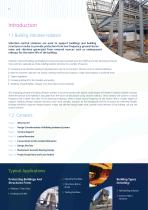
Introduction 1.1 Building Vibration Isolation Vibration control solutions are used to support buildings and building structures in order to provide protection from low-frequency ground-borne noise and vibration generated from external sources such as underground railways for the entire life of the building. Vibration control of buildings and building structures has been practised since the 1960’s and is fast becoming more and more common, especially as whole-building isolation schemes, for a number of reasons: )) Increasing urban densities leading to developments near to rail, transport...
Open the catalog to page 2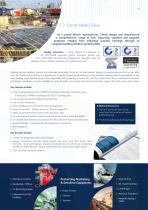
1.3 Farrat Added Value As a proud British manufacturer, Farrat design and manufacture a comprehensive range of ever improving standard and bespoke products; ranging from individual acoustic bearings through to complete building isolation systems (BIS). Quality Assurance - Farrat Isolevel Ltd operates an ISO 9001:2008 approved Quality Assurance System and ISO 14001:2008 Environmental Management Standard, which all Building Vibration Isolation solutions are manufactured under. Building vibration isolation systems are technically demanding. Farrat are the ideal partner, helping to provide...
Open the catalog to page 3
Design Considerations 2.1 Factors to Consider Typically, the primary factors to consider when isolating a building or structure are; )) Steel or concrete frame (e.g. stiffness and mass of the structure, construction tolerances, robustness / disproportionate collapse) )) Characteristics of isolation system (e.g. deflections, access for inspection, replacement, maintenance) )) Lateral restraint )) Isolation line through the building (may lead to complicated connections) )) Interfaces & connections with: )) Neighbouring buildings or structures )) Other floor levels )) Façade & cladding /...
Open the catalog to page 4
2.3 Farrat BVI System Design Examples The schematics below are examples of Building Vibration Isolation system designs developed by Farrat. LO3 Fig 2.1 Isolation of Primary Concrete Frame and Cast In-Situ Ground Floor Slab Fig 2.2 Isolation of Cast In-Situ Ground Beams with Pre-Cast Ground Floor & Steel Frame on Ground Beam Grid Fig 2.3 Isolation of Raft Slab with Full Area Isolation Material Installed on Concrete Blinding Fig 2.4 Isolation Under Ground Floor Slab with Isolation Line Passing Through Cores Fig 2.5 Isolation Under Ground Floor Slab with Cores Isolated at Raft, Requiring...
Open the catalog to page 5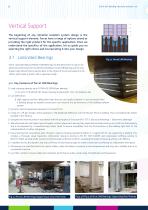
Vertical Support The beginning of any vibration isolation system design is the vertical support element. Farrat have a range of options aimed at providing the right product for the specific application. Once we understand the specifics of the application, let us guide you on selecting the right choice and incorporating it into your design. Farrat Laminated Natural Rubber (LNR) Bearings are the ideal choice to rely on for optimum performance for the life of the building. Farrat LNR Bearings are the only isolator type whose history reaches back to the origins of structural isolation in the...
Open the catalog to page 6
3.2 Full-Area Solutions Farrat Verlimber (VR) is a very-high-performance polyurethane foam that is ideal for full-area solutions where a lower-pressure full-area isolation mat is required. Farrat offer three standard grades, all capable of natural frequencies down to 8 Hz: )) VR16 - Max. working pressure: 3 5kN/m2 )) VR27 - Max. working pressure: 90 kN/m2 )) VR38 - Max. working pressure: 220 kN/m2 Full-area solutions can be installed directly onto consolidated hard-core or a simple blinded concrete slab. As reference, see the case study "Cartwright Gardens" on Pages 26 and 27. Figs 3.5 -...
Open the catalog to page 7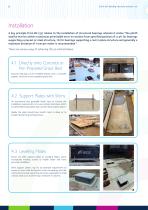
Installation A key principle from EN 1337 relates to the installation of structural bearings wherein it states "the plinth shall be level to within a maximum permissible error in rotation from specified position of: 0.3% for bearings supporting a precast or steel structure, 1% for bearings supporting a cast in place structure and generally a maximum deviation of 1 mm per meter is recommended." There are various ways of achieving this as outlined below: 4.1 Directly onto Concrete or Pre-Prepared Grout Bed Acoustic bearings can be installed directly onto a concrete support structure or...
Open the catalog to page 8
4.4 Fail-Safe Bearing Assemblies Where fail-safes are required in the design these can be provided with or without levelling screws and can also enable vertical ties and other features as required by the design. Fail safes allow the entire assembly to be factory assembled, enabling the bearing assembly to be delivered as one unit with lifting eyes for fast off-loading, distribution and installation. Fabrications can be CE marked and galvanised. 4.5 Bespoke Assemblies The greatest challenge in building isolation systems is not the design of the bearings but how to package all the technical...
Open the catalog to page 9
All buildings will be subject to a degree of lateral loading, typically from wind. The structural design will dictate how that horizontal loading should be resisted, either through stability cores, shear walls or bracing. Lateral Restraint There are numerous approaches to lateral restraint where the ideal solution is dependent on a number of factors inherent in the structural frame design. Either way, the building should be designed to avoid excessive lateral restraint as too much will reduce the effectiveness of the vibration isolation system. 5.1 Acoustic Shear Keys Farrat Acoustic Shear...
Open the catalog to page 10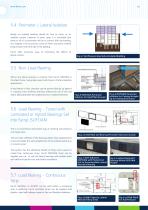
5.4 Perimeter / Lateral Isolation Farrat offer numerous ways of minimising the effects of lateral contact. Ideally, an isolated building should be free to move on its isolation system, however in some cases it is inevitable that some or all of its perimeter will be in contact with surrounding, non-isolated / live structures, some of which may exert a lateral (soil) pressure onto the side of the building. Fig 5.7 Soil Pressure Exerted on Isolated Building 5.5 Non-Load Bearing Where the lateral pressure is minimal, then Farrat ISOFOAM is the ideal choice, having been used in all manner of...
Open the catalog to page 11All Farrat catalogs and technical brochures
-
Isoblocs
3 Pages
-
FSL Isolators
4 Pages
-
PRECISION LEVELLING ELEMENTS
2 Pages
-
Farrat Favim (FV)
2 Pages
-
Farrat Isomat Nitrile (IMNR)
8 Pages
-
Farrat Verlimber (VR)
6 Pages
-
Farrat Vidam (VM)
7 Pages
-
Farrat Squaregrip (SG)
8 Pages
-
Farrat Nitrile (BR)
9 Pages
-
AVA - PLAS - 17a
2 Pages
-
Farrat Jackmounts
2 Pages
-
Farrat Isolated Foundations
36 Pages
-
Farrat Wedgemounts
16 Pages
-
Farrat Isomounts
4 Pages
-
Farrat Isoblocs
3 Pages
-
Farrat Levalators
2 Pages
-
Full Building Isolation
28 Pages
-
Farrat AWTH Acoustic Washers
2 Pages
-
Farrat AWR Acoustic Washers
2 Pages


























